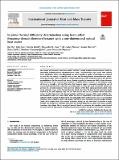Por favor, use este identificador para citar o enlazar a este item:
http://hdl.handle.net/10261/329730COMPARTIR / EXPORTAR:
 SHARE
BASE SHARE
BASE
|
|
| Visualizar otros formatos: MARC | Dublin Core | RDF | ORE | MODS | METS | DIDL | DATACITE | |

| Título: | In-plane thermal diffusivity determination using beam-offset frequency-domain thermoreflectance with a one-dimensional optical heat source |
Autor: | Xu, Kai; Guo, Jiali; Raciti, Grazia; Goñi, Alejandro R. CSIC ORCID; Alonso Carmona, M. Isabel CSIC ORCID ; Borrisé, Xavier CSIC ORCID; Zardo, Ilaria; Campoy Quiles, Mariano CSIC ORCID; Reparaz, J. Sebastian | Palabras clave: | Thermal diffusivity tensor Contactless method In-plane heat transport Thermal anisotropy Line-shaped 1-dimensional heat source Patterned transducers |
Fecha de publicación: | 1-nov-2023 | Editor: | Elsevier | Citación: | International Journal of Heat and Mass Transfer 214: 124376 (2023) | Resumen: | We present an innovative contactless method suitable to study in-plane thermal transport based on beam-offset frequency-domain thermoreflectance using a one-dimensional heat source with uniform power distribution. Using a one-dimensional heat source provides a number of advantages as compared to point-like heat sources, as typically used in time- and frequency-domain thermoreflectance experiments, just to name a few: (i) it leads to a slower spatial decay of the temperature field in the direction perpendicular to the line-shaped heat source, allowing to probe the temperature field at larger distances from the heater, hence, enhancing the sensitivity to in-plane thermal transport; (ii) the frequency range of interest is typically kHz. This rather low frequency range is convenient regarding the cost of the required excitation laser system but, most importantly, it allows the study of materials without the presence of a metallic transducer with almost no influence of the finite optical penetration depth of the pump and probe beams on the thermal phase lag, which arises from the large thermal penetration depth imposed by the used frequency range. We also show that for the case of a harmonic thermal excitation source, the phase lag between the thermal excitation and thermal response of the sample exhibits a linear dependence with their spatial offset, where the slope is proportional to the inverse of the thermal diffusivity of the material. We demonstrate the applicability of this method to the cases of: (i) suspended thin films of Si and PDPP4T, (ii) Bi bulk samples, and (iii) Si, glass, and highly-oriented pyrollitic graphite (HOPG) bulk samples with a thin metallic transducer. Finally, we also show that it is possible to study in-plane heat transport on substrates with rather low thermal diffusivity, e.g., glass, even using a metallic transducer. We achieve this by an original approach based on patterning the transducer using focused ion beam, with the key purpose of limiting in-plane heat transport through the thin metallic transducer. | Versión del editor: | http://doi.org/10.1016/j.ijheatmasstransfer.2023.124376 | URI: | http://hdl.handle.net/10261/329730 | E-ISSN: | 1879-2189 |
| Aparece en las colecciones: | (ICMAB) Artículos (CIN2) Artículos |
Ficheros en este ítem:
| Fichero | Descripción | Tamaño | Formato | |
|---|---|---|---|---|
| Xu_IntJHeatMassTransf_2023_editorial.pdf | Artículo principal | 2,18 MB | Adobe PDF |  Visualizar/Abrir |
| Xu_IntJHeatMassTransf_2023_suppl_editorial.pdf | Información complementaria | 265,02 kB | Adobe PDF |  Visualizar/Abrir |
CORE Recommender
Este item está licenciado bajo una Licencia Creative Commons

